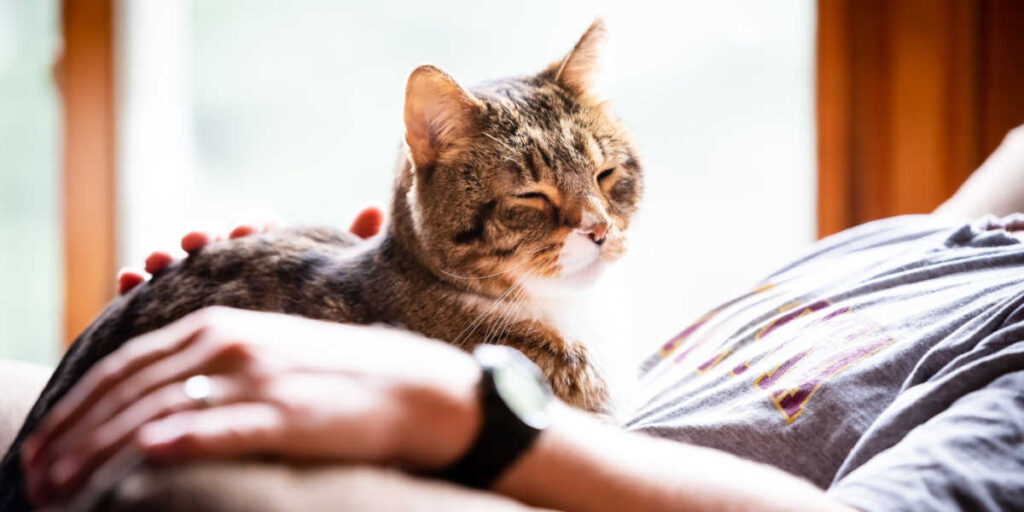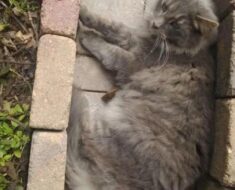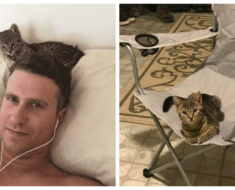One of the hardest things to face is the possibility of a much-loved cat dying. As pet parents, we have a responsibility to monitor the health and well-being of our cats and to take action if we observe pain or distress. Cat owners have the compassionate option to provide hospice care or euthanasia at the end of a cat’s life.

Being able to spot the common signs that your cat is at the end of their life can help ease the decision to help them cross over the rainbow bridge with dignity. These warning signs can include physical symptoms, such as lethargy, incontinence, and difficulty breathing, but also behavioral changes, such as confusion, poor hygiene habits, and hiding.
Although we all wish for our beloved pets to live forever, pet cats have an average lifespan of around 12 to 15 years. Senior cats might suffer from a terminal illness, or your cat’s body may just start to shut down due to old age.
Cats are all individuals, but there are some differences you might find in your pet’s final days that might aid the decision to ask your veterinarian for end-of-life care. Some of these are physical changes, but changes to a cat’s habits, interactions, and behaviors can be very noticeable to pet owners.
Physical Signs That A Cat Might Be Dying
A healthy cat will usually be in fairly good physical condition, with a well-maintained coat, a good appetite, and the ability to perform normal amounts of exercise and hygienic toileting habits. If you’re concerned about your cat’s health, look out for these tell-tale signs that might indicate a dying cat.
- Lethargy And Weakness
A healthy cat will usually be in fairly good physical condition, with a well-maintained coat, a good appetite, and the ability to perform normal amounts of exercise and hygienic toileting habits. If you’re concerned about your cat’s health, look out for these tell-tale signs that might indicate a dying cat.
A cat sleeping is not an unusual sight, and they can indeed snooze for around 16 to 20 hours a day! However, in the last days of life, your cat might show extreme weakness and lethargy. They might not rouse as usual for fuss and attention, and might even sleep through meals and toileting. You might note a lack of mobility, including struggling to rise, general weakness, lack of coordination, and dragging or knuckling of the hind legs.
- Lack Of Appetite/Thirst
A loss of appetite is common in cats that are ill and is often short-lived, but an ongoing inappetence and lack of thirst is a concern. Food refusal can lead quickly to weight loss, weakness, and is an indication of a poor quality of life. Cats cannot survive long without drinking water and will rapidly become dehydrated.
- Weight Loss
Rapid weight loss is a concern in any cat at any age. A sudden drop in condition, especially in older cats or those with chronic illness such as kidney disease, can indicate that the last days are approaching and that the body is shutting down.
- Incontinence
A lack of bladder or bowel control in cats may be due to a treatable medical condition, but it can also be a sign that your cat is approaching the end of their life. Pain when eliminating waste, or any blood in the urine or feces, is also a concern.
- Body Temperature
Cats usually have a fairly high resting body temperature, and will often seek out warm spaces. A drop in a cat’s temperature (below 100 Fahrenheit) is very concerning in cats, and can indicate extreme debilitation or serious illness.
- Breathing And Heart Rate
A sick cat may have an abnormal heart rate or rhythm, and have difficulties breathing. A cat’s heart rate is usually around 160-200 beats per minute, and their breathing rate is around 20-30 breaths per minute.
It can be difficult to calculate your cat’s exact numbers, but if your cat is breathing heavily, with a lot of effort, or with their mouth open, these are signs that something is wrong.
If you notice any of these symptoms in your pet, you should seek advice from a DVM urgently.
Behavioral Signs That A Cat Might Be Dying
Cats are good at hiding signs of illness and pain, and sometimes changes to a cat’s behavior, interactions and habits are easier to spot.
- Hiding
Dying cats often secret themselves away somewhere safe and quiet, as an innate instinct to protect themselves from predators that would target a weak animal. If your cat is hiding all the time, it could mean the end is near.
- Confusion
At the end of life, some cats might become confused, dull, or disorientated. They might appear uncoordinated, weak or have a glazed look to their eyes.
- Changes In Interactions
Sick cats can change how they interact with you or a family member. A cat that is usually cuddly and loves a purring lap snuggle might suddenly shy away from physical contact. Other cats might become intensely clingy.
- Hygiene
Often coupled with incontinence, cats toward the end of their life might struggle with their hygiene. This includes toileting outside the litter box, bad body odor, and poor grooming habits. Cats might appear unkempt, in poor condition, or just plain smelly.





